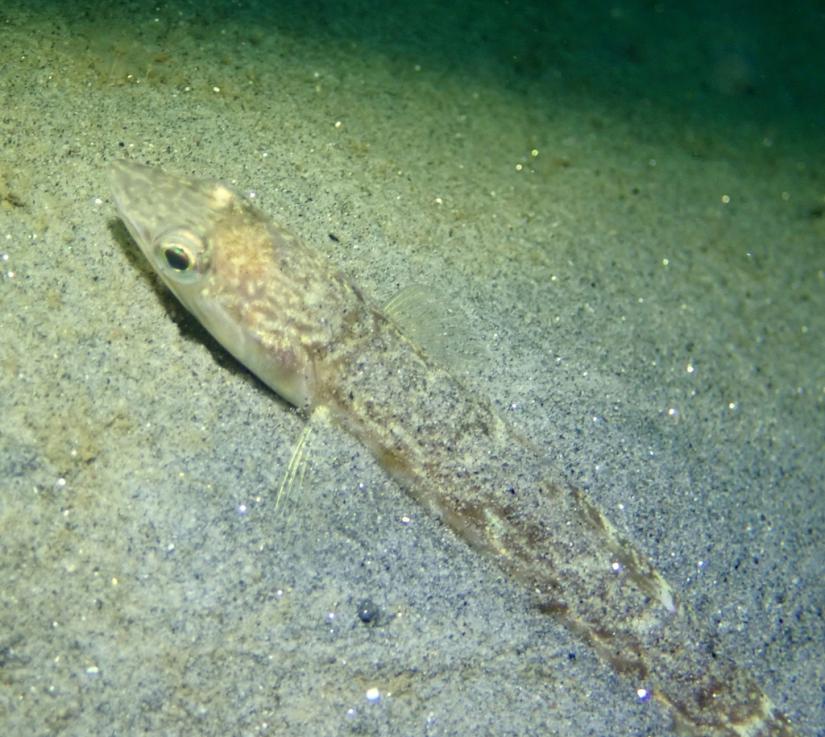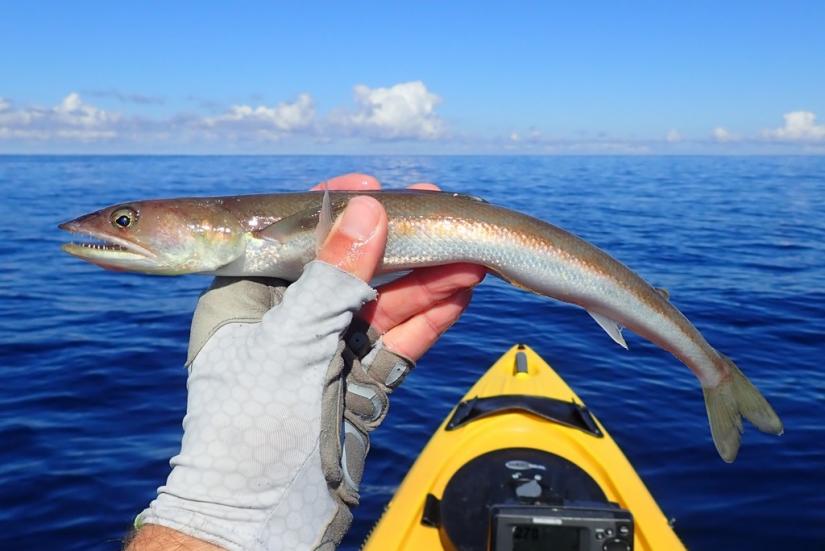California Lizardfish
Synodus lucioceps
The Science
THE SCIENCE
Ambush predators: this fish will usually sit at a slight angle, propped up by its ventral fins and wait for passing fish to attack by surprise.

Taxonomic descirption
- Has a long cylindrical body, with a lizard-like head and mouth. [1]
- Body is uniformly brown on the back, and shades to tan or white on the belly. [1]
- Commonly 30 cm (11.8 inches) in length, and can weigh up to 1.8 kg (4 lbs). [1,2]
Distribution
- Found from as far south as Guaymus, Mexico to as far north as Cape Beal, British Columbia, Canada. Not common north of Point Conception, California. [1]
Life history
- Lays eggs, and has an extended larval period. [1,2]
- Spawning season begins in the summer and peaks in the fall, and larvae are most abundant in the fall and winter, with a peak during September-November. [1,3]
Habitat
- Hides in sandy bottoms in shallow water ranging from 9.1 m to 55 m (30 to 180 feet). [1]
- Ambushes small fishes and squids by sitting on the bottom in wait for passing prey, then rapidly darting upwards to swallow unsuspecting prey in one gulp. [1]
The Fishery
THE FISHERY
This fish can be caught with moving bait, and can be used as bait for other fish.

Seasonal availability
- There is currently no stated seasonal restriction for California lizardfish. [4]
Regulatory and managing authority
- As established by the Marine Life Management Act, the California Fish and Game Commission (CFGC) regulates the fishery, and the California Department of Fish and Wildlife (CDFW) manages this fishery in state waters. [16]
Gear type
- Most lizardfish is caught by hook and line, and recreational gear requirements follow general California guidelines. [4,5]
Status of the fishery
- There is no commercial fishery for the California lizardfish, but it is fished recreationally. [4]
- Currently there is little concern about overfishing or decreasing population, as there is no fishery for this fish. [2,6]
Potential ecosystem impacts
- There are few ecosystem impacts from fishing for this fish, but lost fishing lines may contribute to the problem of ghost fishing. [7]
The Seafood
THE SEAFOOD
This fish is bony but tasty--try it fried


Edible portions
- Fins and head are typicaly removed before eating. [10]
Description of meat
- The meat is white and slightly flakey, and can be bony. [8,10]
Culinary uses
- This fish is usually eaten fried, but can also be baked or grilled. [8,10]
- For a versatile recipe for fried fish, visit The Spruce Eats. [11]
Nutritional information
- Information for 100g of lizardfish (Synodus indicus) can be found on the table to the right. [9]
Toxicity report
- No known toxins. [2]
Seasonal availability
- This fish can be found year-round. [4,5,10]
References
[1] California Department of Fish and Wildlife. 2013. California Marine Sportfish Identification: Other Fishes. Web. https://wildlife.ca.gov/Fishing/Ocean/Fish-ID/Sportfish/Other-Fishes#li…. Accessed 13 July 2020.
[2] Froese, R., Garilao, C.V. n.d. Fishbase. Synodus lucioceps. Web. https://www.fishbase.se/summary/2721. Accessed 13 July 2020.
[3] Moser, et al. 1996. The Early Stages of Fishes in the California Current Region. CalCOFI Atlas No. 33. California Cooperative Oceanic Fisheries Investigations.
[4] California Department of Fish and Wildlife. 2020. 2020 - 2021 Ocean Sport Fishing Regulations. Web. https://wildlife.ca.gov/Fishing/Ocean/Regulations/Sport-Fishing. Accesed 13 July 2020.
[5] California Department of Fish and Wildlife. 2020. California Recreational Ocean Fishing Regulations. Web. https://wildlife.ca.gov/Fishing/Ocean/Regulations/Sport-Fishing/General…. Accesed 13 July 2020.
[6] Lea, B., Béarez, P., McCosker, J. 2010. Synodus lucioceps. The IUCN Red List of Threatened Species. Web. https://dx.doi.org/10.2305/IUCN.UK.2010-3.RLTS.T183220A8074932.en. Acce… 13 July 2020.
[7] National Oceanic and Atmospheric Administration. 2015. Impact of "Ghost Fishing" via Derelict Fishing Gear. NOAA Marine Debris Program Report. Web. https://marinedebris.noaa.gov/sites/default/files/publications-files/Gh…. Accessed 13 July 2020.
[8] Pierfishing in California. 2018. California Lizardfish. Web. https://www.pierfishing.com/california-lizardfish/. Accessed 13 July 2020.
[9] dLife. n.d. Fish, Kdal bral, Fish lizard fish-Nutrition Facts & Calories. Web. https://www.dlife.in/forums/nutritions/93628/view. Accessed 20 July 2020.
[10] Cast & spear. 2019. California Lizardfish Fishing Tips: How to Catch Synodus lucioceps. Web. https://castandspear.com/california-lizardfish-fishing-tips/. Accessed 23 July 2020.
[11] Rattray, D. 2020. Easy Fried Fish Fillet Recipe. The Spruce Eats. Web. https://www.thespruceeats.com/easy-fried-fish-fillets-3056505. Accessed 23 July 2020.
[12] Boehm, A. iNaturalist. 2018. Digital image. Web. https://www.inaturalist.org/observations/18550802. Accessed 12 February 2021.
[13] McKim, S. iNaturalist. 2020. Digital image. Web. https://www.inaturalist.org/observations/60931085. Accessed 12 February 2021.
[14] Cantrell, B. iNaturalist. 2020. Digital image. Web. https://www.inaturalist.org/observations/40571825. Accessed 12 February 2021.
[15] Locklin, J. 2016. Photo of cajun fried catfish. Digital image. Web. https://jennifercooks.com/cajun-fried-catfish/. Accessed 24 July 2020.
[16] Marine Life Management Act. n.d. California Department of Fish and Wildlife. Web. https://wildlife.ca.gov/Conservation/Marine/MLMA. Accessed 24 August 2020.



